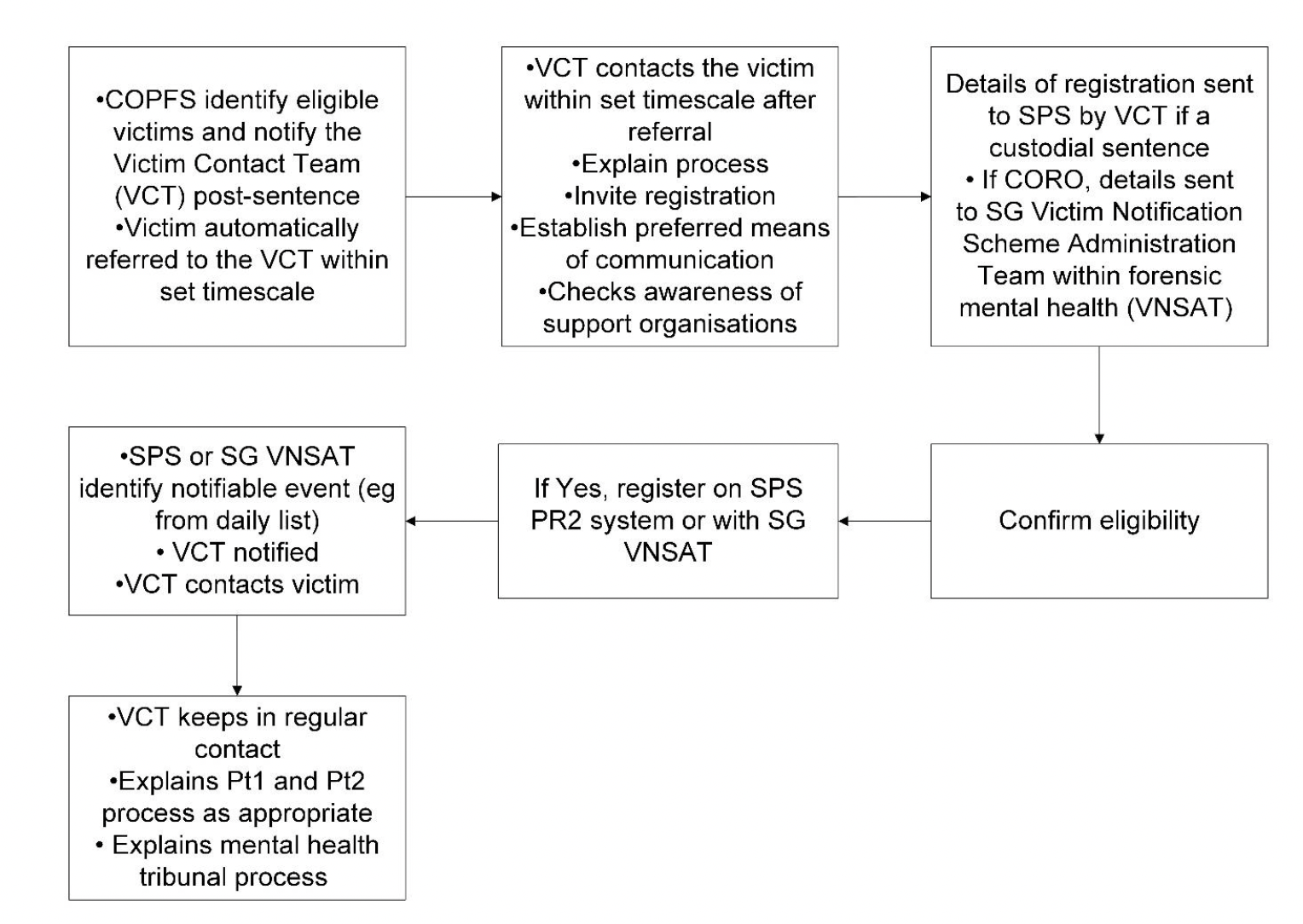Victim Notification Scheme (VNS): independent review
Report of the independent review of the Victim Notification Scheme (VNS). The VNS provides eligible victims information about an offender’s release, and the chance to make representations about parole decisions.
Section 33: What could a new service look like?

We have identified an overwhelming view amongst stakeholders that there should be a single point of contact for victims with the following characteristics:
- There should be one specialist skilled trauma-informed victim contact team to handle all communications with victims
- Team members should be selected on the basis of aptitude to communicate with distressed victims, be well-trained and be suitably qualified. We noted that in some international models, the skill level was at professional psychologist or experienced social worker level
- Victims should be contacted personally at a suitable time after sentencing and offered a conversation by phone, in addition to the official notices
- The contact team member should explain the system, what the sentence means and offer choices around means of communication and easy ways to deregister/ re-register if desired
- There should be one main Victim Notification Scheme website for ready access to information. This could be developed as a tool to communicate victims' wishes
- Communications should have built-in touchpoints, so victims are not left alone for long periods
- Victims should ideally have a named contact in the team, where possible, and one phone number to call or email address
- The team should have effective data-sharing protocols and shared access to relevant data systems for all the holders of relevant critical information
- The team should have strong links with the support organisations to ensure effective and prompt signposting
- Looking ahead, there may be a role for such a team to act as a gateway to Restorative Justice processes
How Should Such A Service Be Managed?
The number of different official organisations involved in delivering the Scheme from government and criminal justice make for a crowded and complex landscape. The process starts with COPFS, moves to SPS, back to SCTS, back to SPS and then PBS. If Hospital Directions or COROs are involved, then a Scottish Government section and the MHTS become involved. We have suggested that Secure Care should also be included. We have also suggested the Scheme be extended to certain Immigration cases. From the victim's perspective, over possibly an extended period of time, they are required to understand and navigate different systems for sentences under and over 18 months, Parts 1 and 2, a variety of temporary release circumstances, movements to and from hospital and a separate process for mentally disordered offenders, if applicable. They might also need to be aware of the deportation process.
There is no clear ownership of this area or one straightforward point of contact for victims. Issues with particular points in the process have to be taken up with the unit where the issue has arisen. Whilst organisations do signpost victims if they have approached somewhere incorrectly, this is an unreasonable burden on the victim.
As the scheme has developed, a common Standards of Service document has been produced with annual reporting by each constituent organisation. This document, as the Thrive Report also noted, collates several organisational annual reports in different formats, with very little data, (other than from SPS), and conveys the impression of a patchwork publication with no evidence of overview or coordinated and measured performance improvement.
We should observe at this stage that we have found the identification of performance data throughout the entire VNS to be difficult to identify and obtain. This in itself testifies to the fragmentation of the Scheme and the need for it to be more coherently performance-managed with objectives, systematic measures to improve performance and holding to account.
We have concluded the management and oversight of the victim contact team we are proposing would lie best outside the existing delivery organisations, in order to have a holistic overview. We propose that the new team be either managed directly by, or be closely accountable to, the Scottish Government Justice Directorate. The Cabinet Secretary for Justice and Veterans and the Scottish Government ultimately have responsibility for the justice system, criminal law procedure and victims and witnesses. We believe the resource cost of the establishment of such a team could be largely met by the redistribution of opportunity costs from elsewhere in the current VNS.
In making our recommendation for the establishment of a new team to provide personalised victim contact, we have not entered into a detailed costing exercise for this review. We wish to give the Scottish Government some leeway in determining where this team might sit and how it might be managed and constituted, as there are a number of ways in which this might be achieved.
Recommendation 20. A new victim contact team. Section 33.
We recommend that a new victim contact team, managed by or accountable to the Justice Directorate, be established, to sit outside the delivery organisations but work closely with them and the victim support organisations, to provide a personalised service for victims.
Recommendation 21. Contact team function. Section 33.
This team should receive automatic referrals from COPFS for victims, where there has been a custodial sentence or Compulsion Order and Restriction Order, within a target period and make personal contact with the victim within another specified target period. The team should offer victims enrolment within the VNS, provide information on the process and their rights and entitlements. They should offer a choice of future communication, including how to opt out of any information not desired and the right to re-enrol at any time of their choice. The team should be managed centrally by or accountable to the Justice Directorate of the Scottish Government and be made up of suitably trained and skilled operatives and be able to operate across all the interested delivery agencies with appropriate data sharing protocols.
Contact
Email: VNSReview@gov.scot
There is a problem
Thanks for your feedback